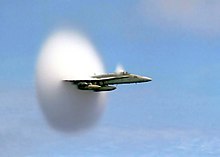Mach number
| Physical key figure | |||||
|---|---|---|---|---|---|
| Surname | Mach number | ||||
| Formula symbol | |||||
| dimension | dimensionless | ||||
| definition | |||||
|
|||||
| Named after | Seriously do | ||||
| scope of application | compressible flows | ||||
The Mach number (also Mach number, Mach number or Mach number, symbol :) is a dimensionless number of fluid dynamics for speeds . It indicates the ratio of the speed (e.g. of a body or a fluid ) to the speed of sound of the surrounding fluid. It is named after the Austrian physicist and philosopher Ernst Mach . The designation Mach number was introduced in 1929 by the Swiss aerodynamicist Jakob Ackeret . Mach describes the ratio of the speed of a body to the speed of sound. If an aircraft is as fast as sound, it is traveling at Mach 1.
definition
The following applies:
- .
Whereby one can use the speed of sound in gases in general, which leads to the following expression:
- .
Are in it
- the isentropic exponent of the fluid under the given boundary conditions,
- the specific gas constant related to the molar mass and
- the temperature of the gas under consideration.
In general, the isentropic exponent also varies for a specific fluid as a function of pressure and temperature . For sufficiently small pressure and temperature changes, it can be approximated as constant.
Mach number = 1, also known colloquially as “Mach 1”, is understood to be the speed of sound (which, to a good approximation, only depends on the temperature for a certain medium). Correspondingly, “Mach 2” (twice the speed of sound), Mach 3 etc. cannot be converted into “exact” speeds without knowing the reference sound speed.
Using the Mach number, however, flows can be divided into different areas, for example:
- subsonic flow,
- transonic flow,
- supersonic flow.
From now on one speaks of hypersonic flow.
These areas require different approaches, since different physical phenomena occur for each area. For example, compressible effects occur in the flows (compressible flow), while such effects usually do not play a role for them (incompressible flow).
aviation


In aviation , the Mach number is used for the dimensionless indication of the airspeed of fast-flying aircraft . It represents the ratio of the airspeed to the speed of sound in the ambient air . Since the speed of sound is primarily dependent on the air temperature , and this in turn depends on the altitude , the display of the Mach number is the only one that is comparable at any cruising altitude and at any ambient temperature Statement. This is particularly important in commercial aircraft to maintain the maximum speed (M MO , Mach Maximum Operating Number ) specified by the aircraft manufacturer with regard to the actual airspeed (TAS, true airspeed) relative to the ambient air . Exceeding the M MO leads to the critical Mach number being reached and thus to boundary layer detachment as the cause of flow breaks and an associated risk of falling, as well as sudden extreme mechanical loads on the aircraft structure. The Mach number is displayed by a special flight instrument, the Machmeter .
| temperature | Speed of sound | |
|---|---|---|
| −50 ° C | 1080 km / h | ≈ 300 m / s |
| −25 ° C | 1134 km / h | ≈ 315 m / s |
| 0 ° C | 1193 km / h | ≈ 331 m / s |
| 20 ° C | 1235 km / h | ≈ 343 m / s |
| 25 ° C | 1245 km / h | ≈ 346 m / s |
At a temperature of −50 ° C and an air pressure of 26 kPa (according to the standard atmosphere, usually at an altitude of approx. 10,000 m), the speed of sound is around 300 m / s = 1080 km / h. A passenger aircraft that flies at a cruising speed of Mach 0.8 under these conditions has a speed of 240 m / s = 864 km / h.
See also
- Laval number
- Cauchy number (similar to the Laval number in solids)
literature
- Ernst Götsch: Aircraft technology . Introduction, basics, aircraft science. Motorbuch-Verlag, Stuttgart 2003, ISBN 3-613-02006-8 .
- Michael Grossrubatscher: Pilots reference guide . 7th, revised edition. Self-published by the author, Munich 2008, ISBN 978-3-00-025252-5 (English).
- N. Rott: Jakob Ackert and the History of the Mach Number. Annual Review of Fluid Mechanics 17 (1985), pp. 1-9.
- N. Rott: J. Ackeret and the history of the Mach number. Swiss engineer and architect 21 (1983), pp. 591–594.
Web links
- Mach number calculator - Java (Engl.)
- Calculator for the speed of sound and Mach number
- The speed of sound and the important temperature
- Mach Number NASA Glenn Research Center (English)
Individual evidence
- ↑ Jakob Ackeret: The air resistance at very high speeds. Schweizerische Bauzeitung 94 (October 1929), pp. 179–183. See also: N. Rott: Jakob Ackert and the History of the Mach Number. Annual Review of Fluid Mechanics 17 (1985), pp. 1-9; N. Rott: J. Ackeret and the history of the Mach number. Swiss engineer and architect 21 (1983), pp. 591–594.
















